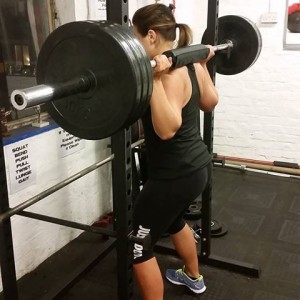To start us off, here’s a short list of some of the most common things I hear when I talk to females about incorporating resistance training into their regime:
- “But I don’t want to get bigger!”
- “My legs are big enough!… I don’t want my legs to get bigger!”
- “I don’t want to look like a man/bodybuilder!”
This makes me want to write an article that simply reiterates the fact that incorporating weight training into your regime will not cause this level of unwanted hypertrophy (studies have shown this time and time again). Instead it will have massive benefits when it comes to fat loss, injury prevention and functionality/performance. (Performance doesn’t just refer to sport, it also refers to our ability to perform day to day tasks and maintain efficient, pain free movement)
However, what about the growing number of females that do want to develop some real muscle mass… We are not talking about extreme levels of bodybuilding, just lean muscle mass that will give the individual that athletic look she wants.
Is a female going to be able to generate good gains when it comes to hypertrophy?… Especially those who don’t have the genetic predisposition to be more muscular and without the use of performance enhancing drugs.
Firstly, what is hypertrophy?
Two types of hypertrophy:
1. Contractile Hypertrophy / Myofibrillar Hypertrophy – Which refers to the muscles adding to their myofibrils in series/parallel (adding Sarcomeres). In layman’s terms – The contractile muscle fibres developing in size.
2. Non-contractile Hypertrophy / Sarcoplasmic Hypertrophy – Which refers to increases in non-contractile elements of a muscle such as glycogen (stored carbohydrate) or collagen.
The experts in muscle physiology firmly hold that there is no qualitative difference in male and female muscle. As a whole both male and female muscles will perform in a similar manner. However, due to the fact that males will generally have more muscle mass and often a higher % of fast twitch muscle fibre in comparison to females, they are therefore generally able to achieve a higher maximal output and a greater capacity for speed and power. (Fast twitch muscle fibres are generally considered to be far more anabolic in nature).
Females on the other hand usually have less muscle mass and generally have a higher % of slow twitch muscle fibres in comparison to males, giving them the edge when it comes to endurance and recovery rates. (Females tend to be able to do more reps at a higher % of their 1RM than males and have been shown to suffer from less muscle soreness)
Not only are these characteristics our predispositions, but they are also often reinforced by the activities we choose and the lifestyles we live. It has been shown that males will tend to gravitate towards training methods that are more anabolic in nature and will stimulate the fast twitch fibres i.e. weight training. Females on the other hand have been shown to gravitate towards training methods that promote more fat loss and stimulation of the slow twitch muscle fibres i.e. cardiovascular type training (CV machines).
Males will also tend to have a much higher calorie intake, the average male does need a higher daily intake to support their basal metabolic rate and daily energy expenditure, but as a whole males tend to eat a much more calorific and high protein diet in comparison to females.
All of the above will have an effect on a person’s ability to stimulate hypertrophy. However, the defining factor which underlines our ability to generate muscle mass is our hormone levels.
The hormones most involved with hypertrophy are Testosterone and IGF-1 (Insulin Growth Factor-1). There’s also a lot of research into GH’s (Growth hormone) effect on hypertrophy. However, it is the difference in Testosterone levels that really has the defining impact on a female’s ability to develop muscle mass in comparison to males. (In short, testosterone acts as a signal calling in the mechanisms that facilitate muscle growth… Protein synthesis etc.)
On average, adult males produce 20 times more testosterone a day than adult females, they also use it at a greater rate, resulting in males having about 10 times more testosterone in their system at any given time.
The testosterone levels of an average female have a dramatic effect on a female’s capacity to develop muscle mass. Although testosterone does have an effect on strength levels, it is clear however that females have the ability to develop strength effectively, with both males and females responding from their pre-training baselines in similar ways… Even muscle hypertrophy in both males and females is fairly similar in the initial weeks of resistance training.
However, as the week’s progress and the level of resistance training is increased. It is likely that although there will be notable strength increases and some increases in contractile muscle fibre, there will also be a decrease in the individual’s body fat % (whilst a healthy diet is maintained). Resulting in an increase in muscle hypertrophy, but an actual decrease in an individual’s overall size (if measured with a tape).
If a female is going to want to develop more notable size in her musculature, she is going to have to maintain a diet that is geared towards that goal i.e. dramatically increase her overall calorie intake (with the right ratios of macronutrients). This increase in energy intake will promote more hypertrophy. However, it’s important to note that a lot of the increases in size will be down to sarcoplasmic hypertrophy and a certain amount of overall weight gain i.e. fat (depending on how well the diet is structured).
In conclusion, yes, females can develop fairly decent levels of hypertrophy if their training and diet is on the ball. However, the levels of testosterone in an average female is going to effect this massively. Realistically the likelihood is that over a training programme that consists of both resistance training and conditioning/cardio based work, there is going to be gains in muscle hypertrophy, but generally an overall reduction in size (whilst maintaining a diet that is not geared towards generating “mass”).
If a female wants to generate more muscle mass… She is going to have to accommodate the resistance training with a diet to match!
Train like an Athlete… Eat like a Nutritionist!

